"When lobster was fertiliser" - What we can learn from old restaurant menus Archives
"When lobster was fertiliser" - What we can learn from old restaurant menus
Glenn Jones, of Texas A&M University, is a palaeo-oceanographer—an archaeologist of the oceans. He investigates both the mysteries of the deep and the secrets of the past. He and a colleague once estimated the temperature of the sea floor a century ago by studying the “isotopic composition” of mollusc shells. His latest method of inquiry, on show this week at the “Oceans Past” conference in Kolding, Denmark, is a little easier to understand. He reads old seafood menus. Lots of them. Mr Jones reckons he and his team have trawled through 40,000 or so, dating back as far as the 1850s.Why? His menus, mostly from American cities on either coast, have allowed him to track the price of seafood back 150 years, much further than anyone has gone before. The menus show that the bountiful seas of centuries past have become more miserly in recent decades. From the early 1920s to the late 1930s, for example, a San Francisco restaurant would charge only $6-7, in today's money, for a serving of abalone, a type of mollusc. By the 1980s, however, abalone was selling for $30-40 a meal. The collapse of abalone stocks prompted a 1997 ban on commercial harvesting off California's coast.
"When lobster was fertiliser," The Economist, October 27, 2005
Seafood prices collected from U.S. restaurant menus dating to the 1850s will help plot the shifting harvest of marine species, according to a study to be announced at Oceans Past a Census of Marine Life conference in Denmark on the History of Marine Animal Populations.Led by paleo-oceanographer Glenn Jones at Texas A&M University at Galveston, researchers are charting over 150 years of inflation-adjusted seafood prices from menus, most from cities such as New York, Boston and San Francisco. The menus shed light on shifting tastes for and supplies of such popular seafood as lobster, swordfish, abalone, oysters, halibut, haddock and sole.
"Restaurant seafood prices since 1850s help plot marine harvests through history," by Terry Collins, press release, EureakAlert, October 23, 2005
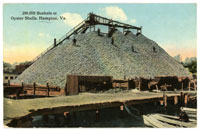
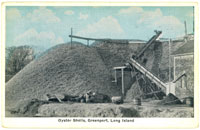
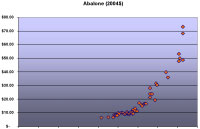
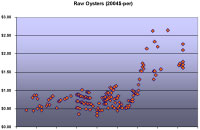
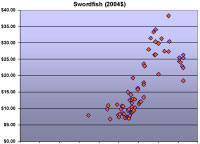
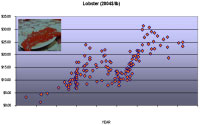
Images and text from "Restaurant Seafood Prices Since 1850s Help Plot Marine Harvests Through History," Census on Marine Life, October 23, 2005
"Before the 1880s, it was unusual to see lobster on menus," said Jones. "It was considered trash fish that people didn't want."
...
"Sea scallops don't show up on the menus until the 1940s," Jones said. "Before that, it was all bay scallops on menus. Now, bay scallops are pretty rare and the ones you get are real small."
"In the 1970s and 1980s, orange roughie starts showing up on menus," Jones said. "But it's a very slow-growing species and they were harvesting it much faster than the species could replace itself so it's becoming commercially extinct."
Fishing boats simply shifted from chasing roughie in waters around New Zealand and Australia to pursuing Chilean sea bass in the southern Pacific and southern Indian oceans.
"They just moved on to another species," Jones said, citing catch statistics. "Now, the same thing is happening with the Chilean sea bass."
"Catch of the day: seafood trends - A Texas A&M oceanographer is poring over menus to analyze fishing," by Kevin Moran, Houston Chronicle, October 23, 2005
More
- "How lobster went up in the world," by Mark Henderson, The (London) Times Online, October 24, 2005
- Glenn Jones, PhD, Texas A&M University at Galveston
- "The Law of the Sea Convention and U.S. Policy," by Marjorie Ann Browne, CRS Issue Brief for Congress, IB95010
- "Endangerd Species; Difficult Choices," by Eugene Buck, M. Lynne Corn, and Pamela Baldwin, CRS Issue Brief for Congress, IB10072
- "The U.N. Law of the Sea Convention and the United States: Developments Since October 2003," by Marjorie Ann Browne, CRS Report for Congress, RS21890
- "Saltonstall-Kennedy Fishery Funding," by Eugene Buck, CRS Report for Congress, May 26, 2004, RS21799
- "Open Ocean Aquaculture," by Rachel Borgatti and Eugene Buck, CRS Report for Congress, RS21914
- "Fishery, Aquaculture, and Marine Mammal Legislation in the 109th Congress," by Eugene Buck, CRS Issue Brief for Congress, IB10139
- "Fishery, Aquaculture, and Marine Mammal Legislation in the 107th Congress," by Eugene Buck, Issue Brief for Congress, IB10074
November 2, 2005 07:02 AM Research
TrackBack
Listed below are links to weblogs that reference "When lobster was fertiliser" - What we can learn from old restaurant menus:
» "When lobster was fertiliser" - What we can learn from old restaurant menus from A Guy In New York
Glenn Jones, of Texas A&M University, is a palaeo-oceanographer—an archaeologist of the oceans. He investigates both the mysteries of the deep and the secrets of the past. He and a colleague once estimated the temperature of the sea floor a... [Read More]







